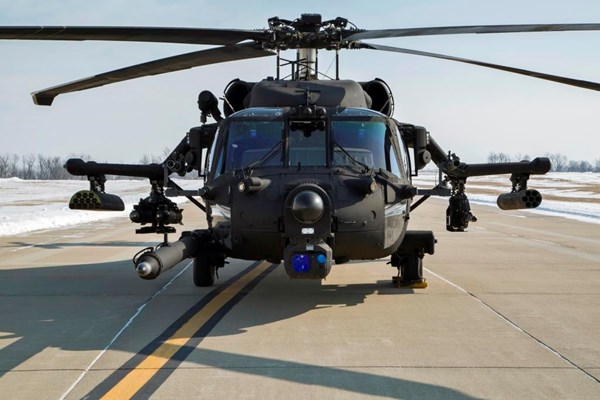Unitech Composites pylons take weight out of Black Hawks
Unitech Composites develops a new weapons-capable pylon for the US Army’s Special Ops Black Hawk, taking 270 lb out of the helicopter and expanding the craft’s versatility.

Black Hawk with Unitech MLASS pylons.
Unitech Composites (Hayden, ID, US) has delivered the first production shipset of its Multi-Station Lightweight Armament Support Structure (MLASS) wings for use on the US Army’s MH-60M (Black Hawk) helicopter. This is the first of nine shipsets that will be delivered to the US Army Special Operations Forces Support Activity (SOFSA). The US Special Operations Forces (SOF) already deploy Unitech’s Lightweight Armament Support Structure (LASS), a single-station weapons pylon for the MH-60.
MLASS is a lightweight, corrosion resistant direct replacement for the External Stores Support System (ESSS). MLASS and LASS weapons stores interface with standard military bomb ejector racks and support a variety of weapons configurations, including the M230 30-mm cannon, the M261 rocket launcher and the M299 missile launcher.
A fully configured set of MLASS wings is 270 lb/123 kg lighter, have better center of gravity and drag characteristics and are quicker and easier to install than a set of standard metallic ESSS wings. Dan Kinney, military programs business development manager for Unitech Composites, says MLASS is a step up from its LASS predecessor, offering two weapons stations on each pylon, compared to one on each LASS.
More importantly, Kinney notes, the weight savings provided by MLASS increase the Black Hawk’s versatility. He says the gross take-off weight of the current generation Black Hawks used by the US Army is 22,000 lb, which is reportedly easily and quickly reached. As a consequence, Kinney says, mission operators of the Black Hawk must often sacrifice fuel for weapons, or vice versa, to stay under the weight limit. Each MLASS pylon weighs 148 lb, for a shipset total weight of 296 lb. With wiring and bomb release racks added, total shipset weight increases to 540 lb, which is 270 lb less than the ESSS shipset weight of 810 lb. Trimming 270 lb from the craft allows that much more fuel or ammunition to be added. The capacity of each weapons stores on the MLASS pylon is 700 lb/318 kg.
Further, Kinney says, the Black Hawk has been, traditionally, a utility helicopter, designed to carry troops and supplies. The option of arming them makes them an attack aircraft, which is proving highly appealing to countries and governments that need such flexibility, or cannot afford to acquire standard attack helicopters.

Black Hawk with Unitech LASS pylons, predecessors to the MLASS.
Unitech uses a combination of automated and hand layup to make the pylons, using a Solvay (formerly Cytec) 350°F cure toughed epoxy prepreg with a carbon fiber plain weave reinforcement. Parts are autoclave cured at 250°F, and post-cured 350°F.
“Thanks to MLASS, our nation’s warfighters no longer have to choose between having more fuel or having more ammo – they can have both,” says Kinney. “We are also excited about this product because it enables the venerable Black Hawk to be a true multi-role aircraft, which we think will resonate well with many UH-60 operators.”
Unitech employs 180 people at its Hayden, ID, location and is part of the larger Unitech Aerospace group, which employs 500 people. Unitech Composites does mostly hand layup, with some automated layup services available as well. The company operates three autoclaves, the biggest being 15 by 30 ft.
Related Content
3D weaving capabilities achieve complex shapes, reduce weight and cost
JEC World 2024: Bally Ribbon Mills is displaying film-infused 3D woven joints, woven thermal protection systems (TPS) and woven composite 3D structures.
Read MoreComposite resins price change report
CW’s running summary of resin price change announcements from major material suppliers that serve the composites manufacturing industry.
Read More3D-woven composites find success in aerospace, space
CAMX 2024: Bally Ribbon Mills experts are displaying the company’s various joints, thermal protection system (TPS) technologies and other 3D woven composites for mission-critical applications.
Read MorePlant tour: Albany Engineered Composites, Rochester, N.H., U.S.
Efficient, high-quality, well-controlled composites manufacturing at volume is the mantra for this 3D weaving specialist.
Read MoreRead Next
VIDEO: High-volume processing for fiberglass components
Cannon Ergos, a company specializing in high-ton presses and equipment for composites fabrication and plastics processing, displayed automotive and industrial components at CAMX 2024.
Read MorePlant tour: Daher Shap’in TechCenter and composites production plant, Saint-Aignan-de-Grandlieu, France
Co-located R&D and production advance OOA thermosets, thermoplastics, welding, recycling and digital technologies for faster processing and certification of lighter, more sustainable composites.
Read MoreDeveloping bonded composite repair for ships, offshore units
Bureau Veritas and industry partners issue guidelines and pave the way for certification via StrengthBond Offshore project.
Read More






















